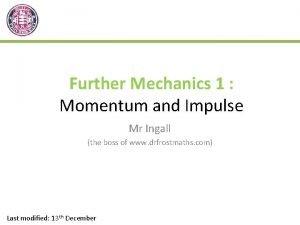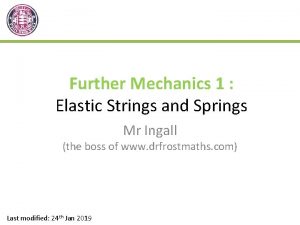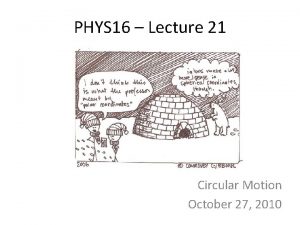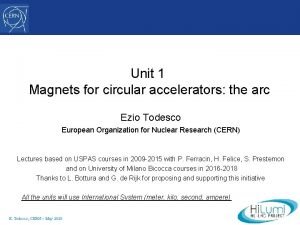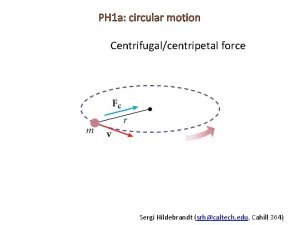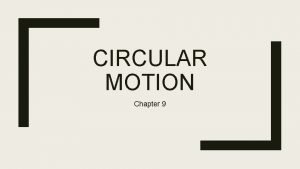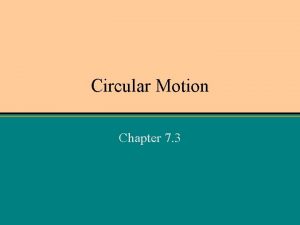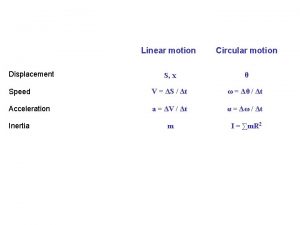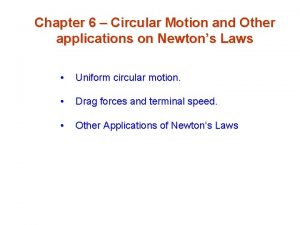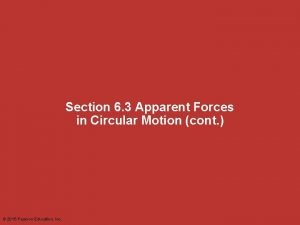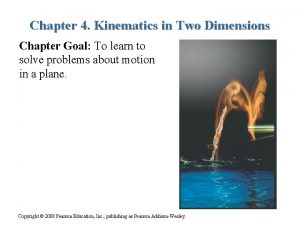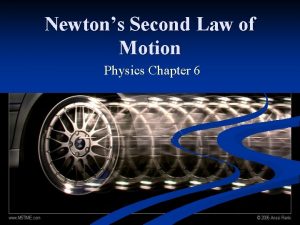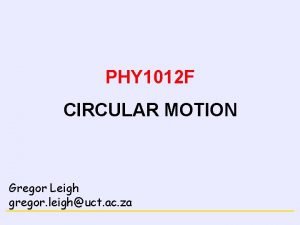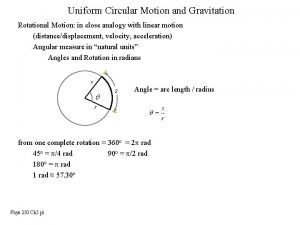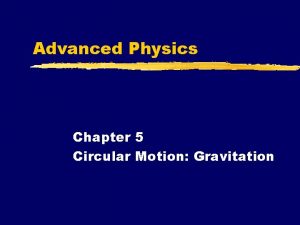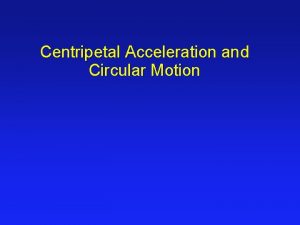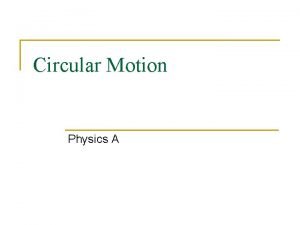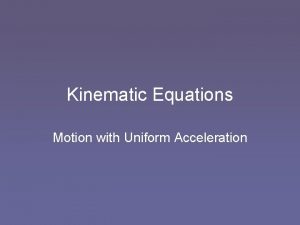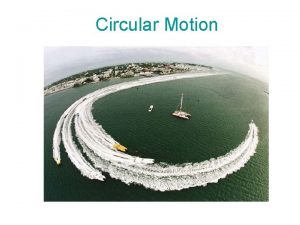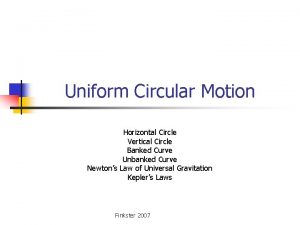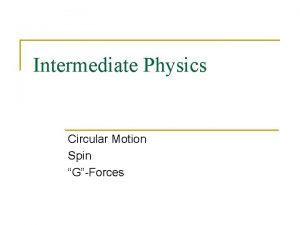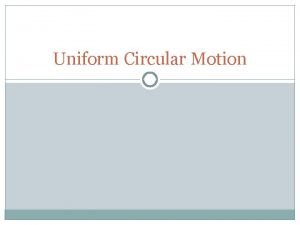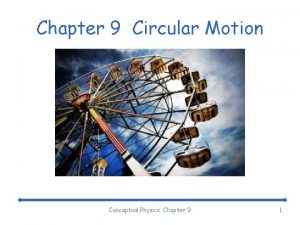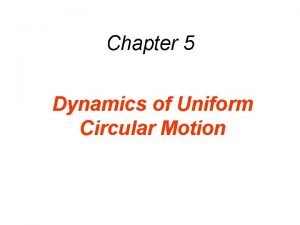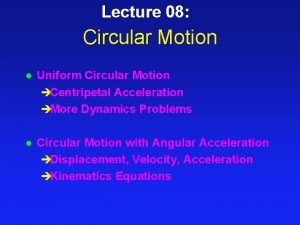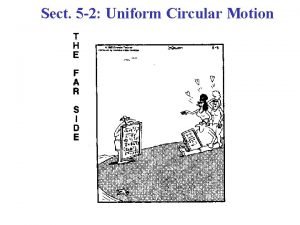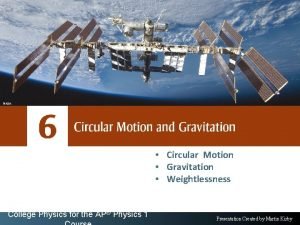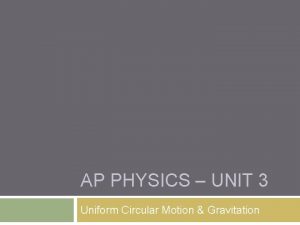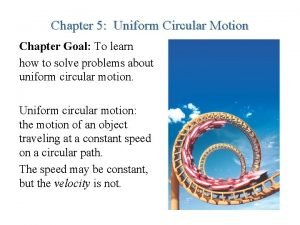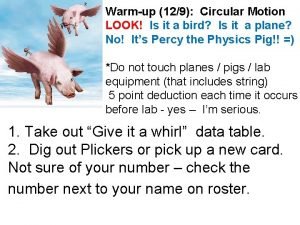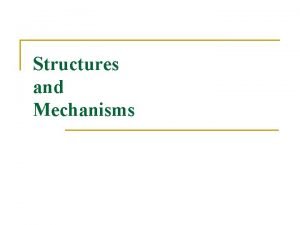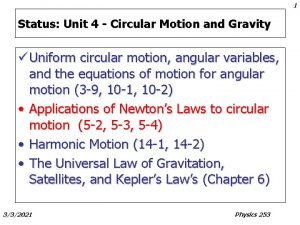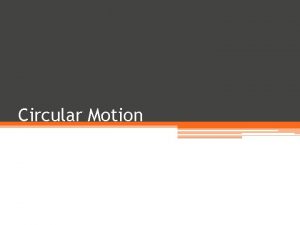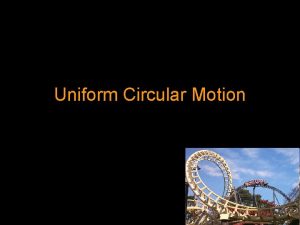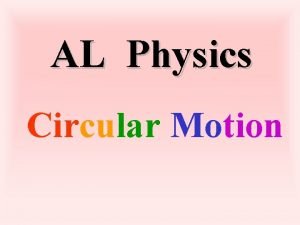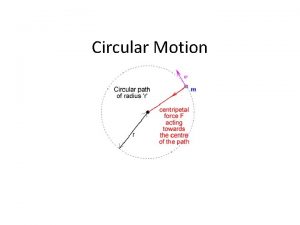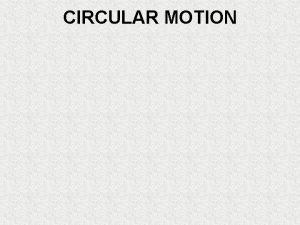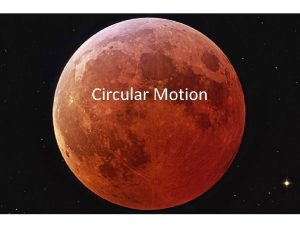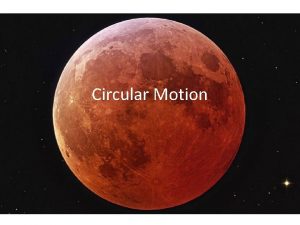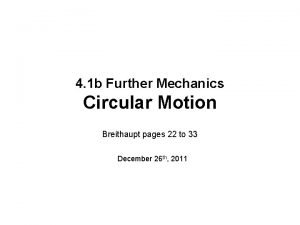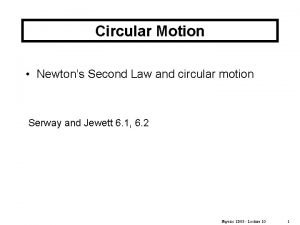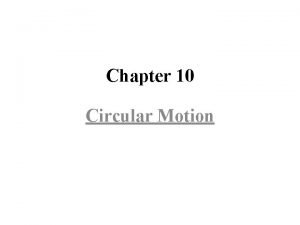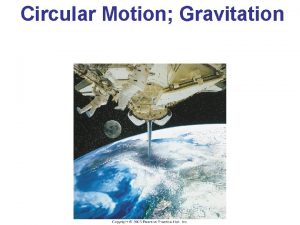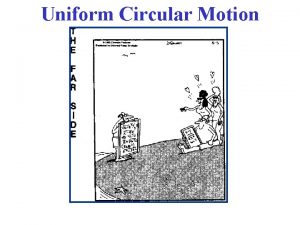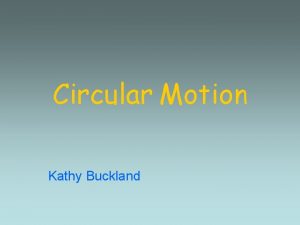Further Mechanics 2 Circular Motion Mr Ingall the













![Conical Pendulum (String at an Angle) [Textbook] A particle of mass 2 kg is Conical Pendulum (String at an Angle) [Textbook] A particle of mass 2 kg is](https://slidetodoc.com/presentation_image_h2/7d6b304ac8c861443256c5f21b271c7e/image-14.jpg)





















- Slides: 35

Further Mechanics 2 : Circular Motion Mr Ingall (the ex-boss of www. drfrostmaths. com) Last modified: 13 th January 2020

Chapter Overview This Chapter is split in two sections: A. Horizontal circles (pages 11 - 18) B. Vertical circles (pages 19 -30) The beginning of the chapter introduces some ideas that are common to both sections. Most A Level papers have two separate questions on circular motion, one on each section. The methods used in each section are very different – be careful not to confuse them! The Specification (from Edexcel) AS and A Level Full A Level only

What is angular speed? ? 15 x 60 ? 900 ? ? 143? (3 SF) Tip: In mechanics, unless the questions specifies otherwise, round answers to 3 SF

Calculating with angular speed A r B O Note: Angular speed is closely related to angular velocity. Angular velocity (a vector) also contains information about the direction of the axis and the sense of rotation. In FM 2 angular speed is synonymous with angular velocity and both are always be denoted as a scalars.

Calculating with angular speed

Calculating with angular speed ?

Exercise 1 A Pearson Further Mechanics 2 Pages 3 -4

P A O Differentiate each component separately using the chain rule.


Quickfire Circular Motion Fill in the gaps in the table below: P O A ? 2 12 10 20 2 15 3 100 ? 10 1 1 5 10 1 ? 6 72 ? ? 40 ? 1 ? ? 45 1000? ?

An Example First: convert all quantities to standard units 1 Diagram? ? The new bit 1 Note: There are many similar situations where a horizontal force causes an object to follow a circular path: - Tension in a horizontal string (textbook e. g. 6) - Reaction from a smooth wire (textbook e. g. 7) - Friction from a rough surface (textbook e. g. 8) (In each case the force could be described as the ‘centripetal force’ – the force, towards the centre of the circle, which causes the object to follow a circular path. The term ‘centripetal force’ is neither used nor needed in FM 2.

Test Your Understanding Edexcel M 3 Jan 2009 Q 3 ?

Exercise 1 B Pearson Further Mechanics 2 Pages 8 -10
![Conical Pendulum String at an Angle Textbook A particle of mass 2 kg is Conical Pendulum (String at an Angle) [Textbook] A particle of mass 2 kg is](https://slidetodoc.com/presentation_image_h2/7d6b304ac8c861443256c5f21b271c7e/image-14.jpg)
Conical Pendulum (String at an Angle) [Textbook] A particle of mass 2 kg is attached to one end of a light inextensible string of length 0. 5 m. The other end of the string is attached to a fixed point A. The particle moves with constant angular speed in a horizontal circle of radius 0. 4 m. The centre of the circle is vertically below A. Calculate the tension in the string and the angular speed of the particle. Preliminary thoughts? Diagram? T?

Banked Surface or Banked Aeroplane A boy rides his cycle round a circular track of radius 25 m. The track is banked at 20⁰ to the horizontal. There is no force due to friction. By modelling the boy and his cycle as a particle of mass 75 kg, find the speed at which the boy is cycling. Diagram? Note: this arrow is NOT A FORCE, it is drawn detached from the particle with a double arrow to show it is acceleration. ?

Two strings 1 ? 2 Diagram ?

Test Your Understanding Edexcel M 3 June 2009 Q 3 ?

Exercise 1 C Pearson Further Mechanics 2 Pages 15 -18

P A O

Solving Problems with Vertical Circles Rationale for Idea 1: In FM 1 Vertical Circles Questions all forces will be radial (directed towards the centre of the circle) except gravity. All radial forces are perpendicular to the motion and therefore do no work* so work is only done against gravity. ! Work in + Initial K. E. + Initial G. P. E. = Final K. E. + Final G. P. E. + Work out

An Example Tip: Start Vertical circles questions by defining where G. P. E. = 0 This is often the lowest point but sometimes the centre - consider which makes calculations easier. B ? Diagram? A

Test Your Understanding Edexcel M 3 June 2009 Q 5 a ?

Just for your interest… What happens if r is not constant? O

Just for your interest… From the previous slide: Names for the components of acceleration: radial centripetal train A 4 B Platform Source: Cambridge University Engineering Department ? coriolis tangential

Exercise 1 D Pearson Further Mechanics 2 Pages 23 -25 qu 1 -5, 11 -16

Conditions for Particles to make Complete Circles In constrained situations: if a particle doesn’t complete a circle it moves backwards and forwards along an arc. In unconstrained situations: if particle leaves circle it travels freely under gravity => use projectile motion. * A constrained situation is one where the body performing can only move back and forth along the arc of the circle – it cannot leave the arc of the circle. In an unconstrained situation, if conditions are right the body may leave the circle.

An Example B ? A

An Example rod Note: this example is very similar but (un)subtley different to the last one. B ? A

Exercise 1 D Pearson Further Mechanics 2 Pages 23 -25 qu 6 -10

When a particle leaves the circle

An Example B b? c? A

Example … continued If P moves freely under gravity => horizontal component of velocity is constant B c? A

Test Your Understanding Edexcel M 3 Jan 2009 Q 7 part a ? Answer to part b (which isn’t really a circular motion question!) on next slide

Test Your Understanding Edexcel M 3 Jan 2009 Q 7 Part b ?

Exercise 1 E Pearson Further Mechanics 2 Pages 28 -30
 Further mechanics 1 unit test 1 momentum and impulse
Further mechanics 1 unit test 1 momentum and impulse Further mechanics elastic strings and springs
Further mechanics elastic strings and springs Element in hair
Element in hair Equation of continuity by euler's method
Equation of continuity by euler's method Acceleration in circular motion
Acceleration in circular motion Relativistic circular motion
Relativistic circular motion Circular motion
Circular motion Circular motion definition
Circular motion definition Instantaneous velocity circular motion
Instantaneous velocity circular motion V = δs/δt
V = δs/δt What causes circular motion
What causes circular motion Physics textbook
Physics textbook Si unit of circular motion
Si unit of circular motion Physics
Physics Circular motion conceptual questions
Circular motion conceptual questions Learning objectives for newton's laws of motion
Learning objectives for newton's laws of motion Circular motion
Circular motion Chapter 5 circular motion gravitation
Chapter 5 circular motion gravitation Circular motion summary
Circular motion summary Circular motion
Circular motion Kinematic equations for circular motion
Kinematic equations for circular motion Circular motion
Circular motion Vertical
Vertical Circular motion
Circular motion Uniform circular motion lab answer key
Uniform circular motion lab answer key State of rest and motion
State of rest and motion Conceptual physics chapter 9 circular motion answers
Conceptual physics chapter 9 circular motion answers Circular motion definition
Circular motion definition Circular motion summary
Circular motion summary Centripetal acceleration
Centripetal acceleration Circulatory motion
Circulatory motion Ap physics unit 3 circular motion and gravitation
Ap physics unit 3 circular motion and gravitation How to solve circular motion problems
How to solve circular motion problems Dynamics of uniform circular motion
Dynamics of uniform circular motion Mechanism and structure
Mechanism and structure Non uniform circular motion examples
Non uniform circular motion examples
